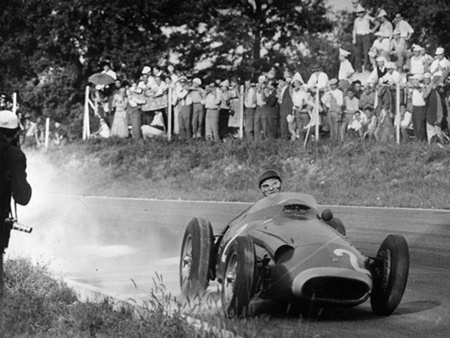The UK is a great place for books. And not for much else, I will add, and sorry if that offends any UK readers.
My eldest son and I went over to the UK in November. Yes, I know it is getting close to winter, and the weatherman even produced snow for us after the first night of minus four degrees temperature. It did warm up to plus six degrees during the day, veritable tropical temperatures.
 Fangio driving the wheels off the Maserati
Fangio driving the wheels off the Maserati
I mentioned to my son that I have no idea why our forefathers decided that the north of Scotland would be a great place to settle in, don a hairy skirt with no undies, and go and herd sheep on the moors, which are also wet. They should have been locked up. They had lunatic asylums for nutters like them, and heaven help me, I’m descended from a bunch of loonies!
But back to books. On every trip to the UK I have managed to find some incredible book bargains, some in the new bookshops, and others in the second hand places. For example I spied a book on classic cars in Waterstones, a large British book chain, and this book with several color plates was on special at 75 percent off. I paid six pounds 25 pence plus one new penny extra to get a plastic bag strong enough to carry it. It has everything in it from the 1901 Curved Dash Oldsmobile up to the Dodge Viper, a long time favourite of mine, a car with more neddies under the bonnet than you could ever use on the road, and on the race track it was truly awesome. All the steering was done with the right foot, and I loved it.
Another book purchase was found in a second hand gift shop on the quay at Exeter. This is a wonderfully detailed history of motor racing from 1894 (yes, 1894) until 1989. Cost? Seven British pounds ninety five new pence, or around 350 Thai baht. For that small sum I have gleaned such details as the win by Christian Lautenschlager in the 1914 French Grand Prix. His Mercedes had a 4.5 litre engine with four cylinders. Two inlet valves and two exhaust valves with an overhead cam shaft – not bad for 1914. His winning time was seven hours eight minutes for the 700 km race. It makes our present day over-pampered race drivers seem like a bunch of girlies. Maybe I shouldn’t be so tough on them, but they are a bunch of over-paid pansies.
The 1957 GP at the Nurburgring is given many pages, as it deserves. This was the race won by Juan Manuel Fangio in the 250F Maserati, coming from behind after a 56 second pit stop for fuel and tyres. Hunting down Mike Hawthorn and Peter Collins in Ferrari’s, Fangio took 24.2 seconds off the lap record. You read that correctly, 24.2 seconds. Nobody had ever done something like that before, or since. After the race, the respected journalist Gunter Molter wrote, “Fangio’s younger colleagues will now look up to him as someone unsurpassed, the grand old master of GP racing who can drive like no-one else.”
The 1967 Italian GP was also memorable, with Jim Clark in the Lotus losing one complete lap in the pits, to then chase the field, drive through it and take the lead, only to run out of fuel on the last corner and was passed by John Surtees and Jack Brabham. Surtees won by half a car. And his car? It was the Honda RA 300 with a 48 valve V12 developing 405 bhp at 10,000 rpm. Such wonderful history, and here we are in 2011 and Honda withdrew from the sport in 2009. Shame!
As I turned the last page of 1989, there was another shame. It was a list of all the Formula 1 cars of that year. There were 20 different makes of cars. These days we are lucky if we get 20 cars on the grid, let alone 20 different teams. For interest, here they are: AGS, Arrows, Benetton, Brabham, Colloni, Dallara, EuroBrun, Ferrari, Ligier, Lola, Lotus, March, McLaren, Minardi, Onyx, Osella, Rial, Tyrrell, Williams and Zakspeed.




